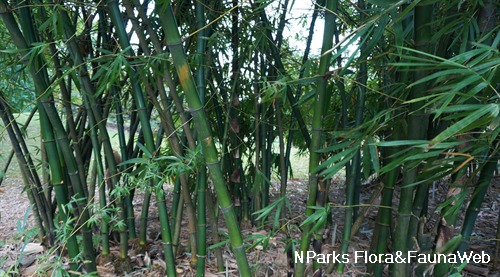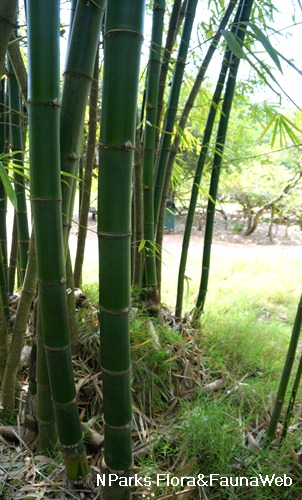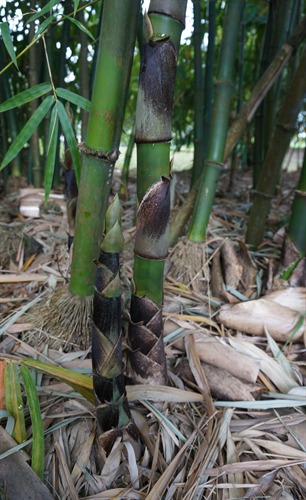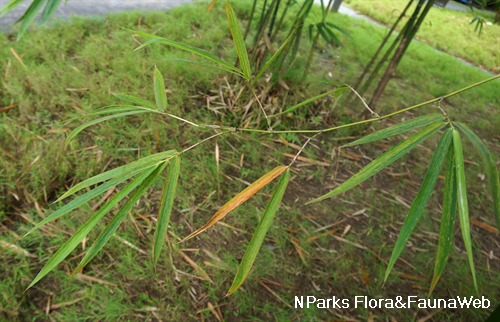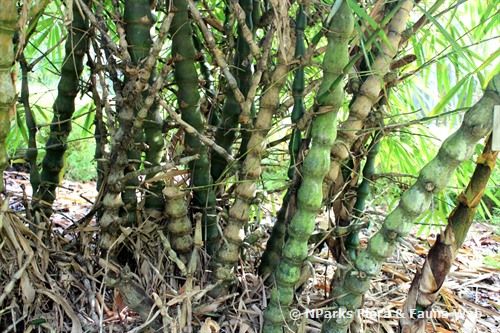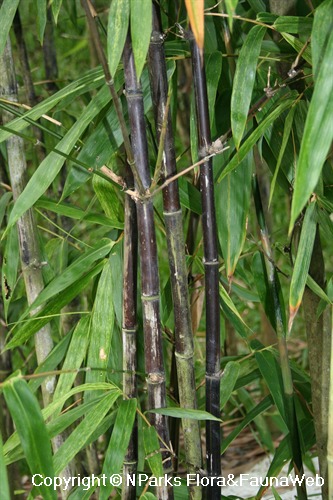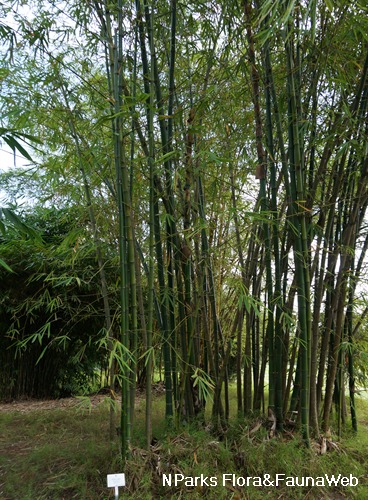
Back
Bambusa vulgaris
| Family Name: | Poaceae (Gramineae) |
| Synonyms: | Bambusa auriculata |
| Common Name: | Common Bamboo, Golden Bamboo, 泰山竹, 龙头竹 |
Name
Classifications and Characteristics
| Plant Division | Angiosperms (Flowering Seed Plants) (Monocotyledon) |
|---|---|
| Plant Growth Form | Grass or Grass-like Plant (Tall Grass (Poaceae)) |
| Lifespan (in Singapore) | Perennial |
| Mode of Nutrition | Autotrophic |
| Maximum Height | 20 m |
Biogeography
| Native Distribution | Southeast Asia, Pantropical |
|---|---|
| Native Habitat | Terrestrial |
| Preferred Climate Zone | Tropical, Sub-Tropical / Monsoonal |
| Local Conservation Status | Non-native (Horticultural / Cultivated Only) |
Description and Ethnobotany
| Growth Form | Large bamboo forming erect clumps up to 20 m tall. |
|---|---|
| Foliage | Leaves are lance-shaped with a rough leaf margin (30 cm long, 4 cm wide). About 8-9 leaves are arranged along each branch. Young leaves are bright yellow, eventually turning green and then brown. |
| Stems | The woody, aboveground stems are known as culms and grow up to 4-10 cm wide. The underground part of the stem is known as a rhizome. |
| Flowers | Tiny, reduced flowers known as florets are arranged in oblong, flattened spikelets (1-2 cm long). Each spikelet contains 4-12 fertile florets. |
| Fruit | One-seeded, dry, indehiscent fruits are known as grains. |
| Ethnobotanical Uses | Food (Fruit or Vegetable): Immature shoot tips are eaten as a vegetable. Medicinal: In Trinidad and Tobago, the leaves are used to treat diarrhoea or parasites in dogs. Timber & Products: Bamboo culms are used to make fences, huts, boats, furniture, and paper. Split stems are used to make brooms, baskets and musical instruments. |
Landscaping Features
| Desirable Plant Features | Ornamental Stems, Ornamental Form |
|---|---|
| Landscape Uses | General, Parks & Gardens, Small Gardens, Hedge / Screening, Slope Stabilization |
| Thematic Landscaping | Zen / Minimalist Garden |
Plant Care and Propagation
| Light Preference | Full Sun, Semi-Shade |
|---|---|
| Water Preference | Moderate Water |
| Rootzone Tolerance | Moist Soils, Well-Drained Soils |
| Propagation Method | Seed, Storage Organ (Rhizome) |
Foliar
| Foliage Retention | Evergreen |
|---|---|
| Mature Foliage Colour(s) | Green |
| Mature Foliage Texture(s) | Rough |
| Foliar Type | Simple / Unifoliate |
| Foliar Attachment to Stem | Sessile |
| Foliar Shape(s) | Non-Palm Foliage (Lanceolate) |
| Foliar Venation | Parallel |
| Foliar Apex - Tip | Acuminate |
| Foliar Base | Rounded / Obtuse |
Floral (Angiosperm)
| Flower Grouping | Cluster / Inflorescence |
|---|---|
| Inflorescence Type | Spikelet / Pseudospikelet / Compound Spike |
Fruit, Seed and Spore
| Fruit Classification | Simple Fruit |
|---|---|
| Fruit Type | Indehiscent Dry Fruit , Caryopsis / Grain |
Image Repository
Others
| Master ID | 29291 |
|---|---|
| Species ID | 3600 |
| Flora Disclaimer | The information in this website has been compiled from reliable sources, such as reference works on medicinal plants. It is not a substitute for medical advice or treatment and NParks does not purport to provide any medical advice. Readers should always consult his/her physician before using or consuming a plant for medicinal purposes. |

